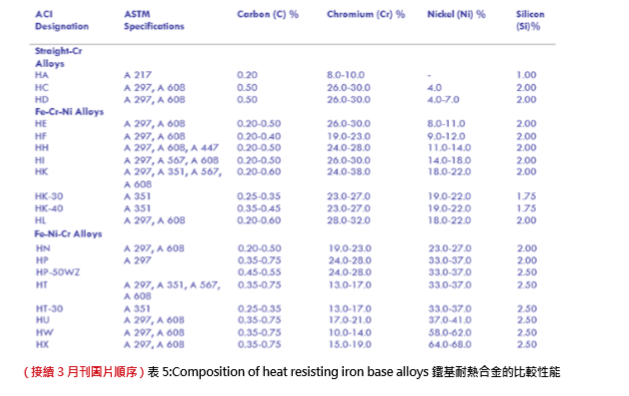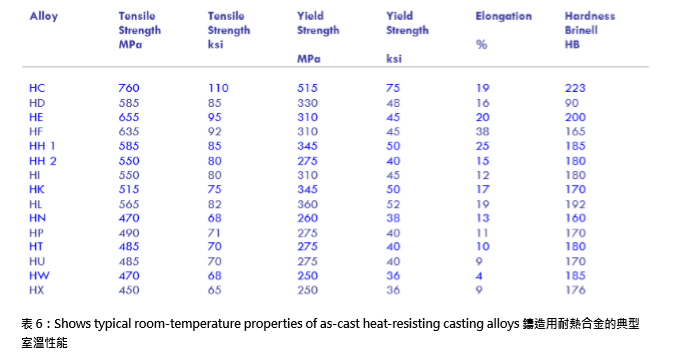New Material Direction of MIM MIM材料的新方向(二)
接續三月刊
第 III 部 分
Introduction of Iron Base Heat Resistant Alloys鐵基耐熱合金的簡介 在網上看到一篇來自ACME公司的技術文件,頗令Dr. Q 好奇,标题是耐热铸铁合金(Heat Resistant Castings-Iron Base Alloys),因为铸造是咱MIM的竞争制程,那么我们 来看看,有没有机会理解并取代这些材料。
3.1以鑄造法來獲得耐熱合金
Castings are classified as heat resistant if they are capable of sustained operation while exposed, either continuously or intermittently to operating temperatures that result in metal temperature in excess of 650 ° C (1200 ° F). Alloys used in castings for such applications fall into four broad categories. A number of proprietary alloys viz. AiResist, Haynes, Inconel, Rene, Udimet, Hastelloy, MAR-M, RA-330, Nimonic and many other alloys developed by companies viz. Inco Alloys, Rolled Alloys, Carpenter Alloys, Krupp VDM, also fall within the four categories mentioned below: The discussion in this technical paper is restricted to iron-base alloys.
[1] 鑄造件被列為耐熱性的,甚麼算是耐熱的範圍? 金屬材 料如能持續操作於650°C(1200°F)連續或是斷續地工 作便算是耐熱,通常金屬鑄件在這種應用環境下合金分為四大類;當然有許多專有合金的開發公司如:AiResist, Haynes, Inconel, Rene, Udimet, Hastelloy, MAR-M, RA-330, Nimonic和許多其他合金的開發公司,常見的 Inco合金、卡本特合金、克虜伯VDM,也都屬於下列 四類(本論文討論僅在鐵合金)[1]
■Iron-base heat resistant alloys鐵基熱阻合金 •Straight Chromium alloys 強化鉻鐵合金 – 牌號 HA, HC, HD •Iron-Chromium-Nickel (Fe-Cr-Ni) alloys鐵鉻鎳合金牌號HE, HF, HH-I, HH-II, HP-50WZ, HK, HK-30, HK40, HK-50, HL •Iron-Nickel-Chromium (Fe-Ni-Cr) alloys鐵鎳鉻合金牌號HN, HP, HT, HU, HW, HX
■Nickel-base heat resistant alloys鎳基熱阻合金
■Cobalt-base heat resistant alloys鎳基熱阻合金
■Super alloys超合金 •Iron base super alloys鐵基超合金
•Nickel base super alloys鎳基超合金
•Cobalt base super alloys鈷基超合金
Table 5 shows the representative ASTM/ ACI compositions of iron-base heat resistant casting alloys. Other alloy standards DIN (Germany), BS (U.K.), ISO have their corresponding counterparts of heat resisting alloys designated to their respective standards but have inherently similar elemental chemical composition ranges. ASTM/ ACI standards are referred here, as they are the most popular and widely accepted materials & alloy standards across the world. ACME Alloys manufactures its own proprietary alloys and proprietary alloys that are developed by companies, to meet a particular industry application or for superior performance in specific environments compared to generally available standard alloys.
表5顯示了具有代表性的ASTM/ACI標準鐵基耐熱鑄造 合金。其他的合金標準如DIN(德國)、BS(英國)、ISO 有其相應的耐熱指定各自的標準,但有本質上都有相似 的元素與合金的化學成分範圍。 這裡提到是採用美國的ASTM/ACI標準,因為它們是世 界上最流行和被廣泛接受的材料和合金標準。 ACME合金公司製造屬於自己專有合金和標準專用合金,以滿足 特定的工業應用或在特定環境中比一般可用的標準合金 優越的性能。
編者:這點Dr. Q來說明下,我們採用粉末成型技術(包 含PM, MIM與3D打印)可以在有條件的知識背景以及 客戶同意的狀況下(注意到必須取得第三方認證時,要 送驗檢查以避免爭議),粉末技術可以完成比鑄造更多 的材料成分組合與性能調整,這是我們的新機會讓MIM 進入耐熱應用的領域。

Lengend說明
American Society of Testing Materials (ASTM) specifications are the same as Alloy Casting Institute (ACI) specifications. Remainder is Fe in all alloy compositions. Mo, Al, Ti, W, V, Nb, Cb, B, and Ta are added intentionally, in appropriate proportions as trace elements for achieving enhanced physical properties and superior, stable grain microstructure.
美國材料試驗協會(ASTM)規範與合金鑄造協會(ACI) 規範是相同的,其他餘量是所有合金成分中的鐵。故意 添加鉬、鋁、鈦、鎢、釩、鈮、炭黑、硼和Ta,以適當 比例作為微量元素,以獲得增強的物理性能和優越的、 穩定的晶粒微觀結構。
3.2 Properties of Heat Resistant Alloys 耐熱合金的性質
In application of heat resistant alloys, paramount considerations include:耐熱合基金的在應用上,應該 包含下列性能
■Resistance to corrosion at elevated temperatures在 高溫狀態下可以耐溫腐蝕
■Stability (resistance to warping, cracking or thermal fatigue)熱穩定性(抗翹曲、開裂或熱疲勞)
■Creep strength (resistance to plastic flow)抗熱蠕變/ 潛變(抗熱塑性流動)
3.2.1 Elevated-Temperature Tensile Prop erties升溫態的拉伸性能
The short-term elevated-temperature test, in the standard tension test bar is heated to a designated uniform temperature and then strained to fracture at a standard rate, identifies the stress due to a shortterm overload that will cause fracture in uni-axial loading. 這是短時間的高溫試驗,在標準拉伸試棒加熱到指定的 溫度並等待均勻化後,然後以標準速率拉伸進行直到斷 裂,確定載入應力來自短期時間超載所導致於單一軸向 的斷裂。
3.2.2 Creep and Stress Rupture Properties 蠕變和耐久性能
Creep is defined as the time-dependent strain that occurs under load at elevated temperature and is operative in most applications of heat-resistant highalloy castings at the normal service temperatures. In time, creep may lead to excessive deformation and even fracture at stresses considerably below those determined in room temperature and elevatedtemperature short-term tension tests.
蠕變是指在高溫下負載作用下發生的應變隨時間變化的 現象,適用於高溫高強度合金鑄件在正常使用溫度下的 應用。蠕變時,在室溫和高溫短時拉伸試驗中,蠕變可 能導致過大的變形甚至斷裂。
When the rate or degree of deformation is the limiting factor, the design stress is based on the minimum creep rate and design life after allowing for initial transient creep. The stress that produces a specified minimum creep rate of an alloy or a specified amount of creep deformation in a given time (for example, 1% of total 100,000 h) is referred to as the limiting creep strength, or limiting stress.
當變形速率或變形程度為限制因素時,設計應力是基於 允許初始蠕變的最小蠕變速率和設計壽命。在給定的時 間內產生合金的規定最小蠕變速率或一定量的蠕變變形 的應力(例如:總的100000小時的1%)被稱為極限蠕 變強度或極限應力。
Stress rupture testing is a valuable adjunct to creep testing and is used to select the section sizes necessary to prevent creep rupture of a component. It should be noted that the long-term creep and stress-rupture values (For example, 100,000 h) are often extrapolated from short-term tests. Whether these property values are extrapolated or determined directly often has little bearing on the operating life of high-temperature parts. The actual material
behaviour is often difficult to predict accurately because of the complexity of the service stresses, different applications, relative to the idealized, uniaxial loading conditions in the standard tests, and because of the attenuating factors such as cyclic loading, temperature fluctuations, and metal loss from corrosion. The designer and the metallurgist should anticipate the synergistic effect of these variables.
應力斷裂試驗是蠕變試驗的一個有價值的輔助材料,用 於選擇防止構件蠕變斷裂所需的截面尺寸。需要注意的 是,如何把長期蠕變和應力破裂值(例如:100000小時) 經常從短時間試驗中給推斷出來,這些數值是否被直接 外推或確定,往往與高溫部件的使用壽命無關。由於標 準試驗中理想化的單軸載荷條件,以及由於循環載荷、 溫度波動和腐蝕金屬損耗等衰減因素的影響,實際材料 行為往往難以準確預測。設計者和冶金學家應該預見到 這些變量的協同作用。
編者:這種長周期的行為預測,是很難以準確地知道那 些影響因素最重要,這在幾種性質的比較如鹽霧測試、 冷熱衝擊、疲勞等,都是這樣的效果,所以對於蠕變性 質是很需要協同合作的。

3.2.3 Thermal Fatigue熱疲勞
Thermal fatigue involves cracking caused by heating and cooling cycles. Very little experimental thermal fatigue information is available on which to base a comparison of the various alloys, and no standard test to date has been adopted. Field and industry experience indicates resistance to thermal fatigue is usually improved with an increase in nickel content. Niobium/Columbium-modified alloys have been employed successfully when a high degree of thermal fatigue resistance is desired, such as in glass forming and reformer outlet headers, where rapid heating and cooling takes place of the parts.
熱疲勞包括加熱和冷卻循環引起的裂紋。很少有實驗性 的熱疲勞信息可以用來比較各種合金,目前還沒有標準 測試。現場和工業經驗表明,抗熱疲勞性能通常隨著鎳 含量的增加而提高。鈮/鈳改性合金已成功應用在高的 熱疲勞抗力,是理想的,如在玻璃形成加工和轉化爐出 口集箱,在快速加熱和冷卻的地方。
3.2.4 Thermal Shock Resistance 抗熱震衝擊
Thermal shock failure may occur as result of a single, rapid temperature or as result of rapid cyclic temperatures changes that induce stresses high enough to cause failure. Thermal shock resistance is influenced by the coefficient of thermal expansion and the thermal conductivity of materials. Increases in the thermal expansion coefficient or decreases in the thermal conductivity reduce the resistance against thermal shock.
熱衝擊失效可能是由於單一的、快速的溫度或由於快速 循環溫度變化導致應力足夠高而導致失敗的結果,抗熱 衝擊性受材料熱膨脹係數和導熱係數的影響。熱膨脹係 數的增加或熱導率的降低降低了抗熱衝擊性。■
